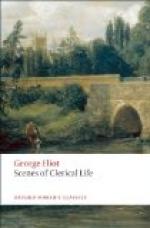Mr. Pugh’s vis-a-vis is the Rev. Martin Cleves, a man about forty —middle-sized, broad-shouldered, with a negligently-tied cravat, large irregular features, and a large head, thickly covered with lanky brown hair. To a superficial glance, Mr. Cleves is the plainest and least clerical-looking of the party; yet, strange to say, there is the true parish priest, the pastor beloved, consulted, relied on by his flock; a clergyman who is not associated with the undertaker, but thought of as the surest helper under a difficulty, as a monitor who is encouraging rather than severe. Mr. Cleves has the wonderful art of preaching sermons which the wheelwright and the blacksmith can understand; not because he talks condescending twaddle, but because he can call a spade a spade, and knows how to disencumber ideas of their wordy frippery. Look at him more attentively, and you will see that his face is a very interesting one —that there is a great deal of humour and feeling playing in his grey eyes, and about the corners of his roughly-cut mouth: a man, you observe, who has most likely sprung from the harder-working section of the middle class, and has hereditary sympathies with the checkered life of the people. He gets together the working men in his parish on a Monday evening, and gives them a sort of conversational lecture on useful practical matters, telling them stories, or reading some select passages from an agreeable book, and commenting on them; and if you were to ask the first labourer or artisan in Tripplegate what sort of man the parson was, he would say,—’a uncommon knowin’, sensable, free-spoken gentleman; very kind an’ good-natur’d too’. Yet for all this, he is perhaps the best Grecian of the party, if we except Mr. Baird, the young man on his left.
Mr. Baird has since gained considerable celebrity as an original writer and metropolitan lecturer, but at that time he used to preach in a little church something like a barn, to a congregation consisting of three rich farmers and their servants, about fifteen labourers, and the due proportion of women and children. The rich farmers understood him to be ‘very high learnt;’ but if you had interrogated them for a more precise description, they would have said that he was ’a thinnish-faced man, with a sort o’ cast in his eye, like’.
Seven, altogether: a delightful number for a dinner-party, supposing the units to be delightful, but everything depends on that. During dinner Mr. Fellowes took the lead in the conversation, which set strongly in the direction of mangold-wurzel and the rotation of crops; for Mr. Fellowes and Mr. Cleves cultivated their own glebes. Mr. Ely, too, had some agricultural notions, and even the Rev. Archibald Duke was made alive to that class of mundane subjects by the possession of some potato-ground. The two young curates talked a little aside during these discussions, which had imperfect interest for their unbeneficed minds; and the transcendental and near-sighted Mr. Baird seemed to listen somewhat abstractedly, knowing little more of potatoes and mangold-wurzel than that they were some form of the ‘Conditioned’.




